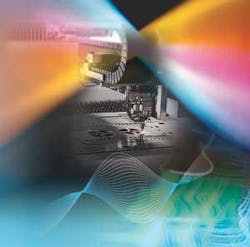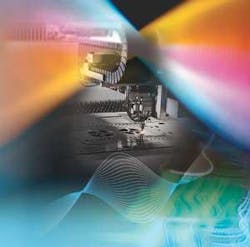Software for laser cutting applications
Using one advanced CAM nesting software for many tools may reduce time and cost
Derek Weston
Advances in laser cutting technology continue to move forward, penetrating new user segments based on factors including increased thickness capacity and lower initial investment. Achieving the best results from laser systems, new or old, requires advanced CAM nesting software. Although software from the machine manufacturer is often supplied, CAM software developed by independent suppliers may provide superior solutions, particularly to two of the larger laser user segments: job shops and product manufacturers. These segments often operate more than one laser in the same facility and using one single nesting software solution to program all machines presents significant advantages in terms of programming time, product training, and software investment.
Common problems faced by these segments include managing import of various CAD file formats, including 3D CAD, productivity needs in order to achieve maximum ROI from laser capital investment, material management, and part quality. Independent CAM software solutions can assist job shops and product manufacturers in these key areas.
CAD file formats
Nesting software that can accept many CAD formats allows users the flexibility to interface with both 2D and 3D CAD files, including AutoCAD, SolidWorks, Inventor, SolidEdge, ProEngineer and many more. Typically it is possible to unfold 3D files and bring them directly into the nesting program without creating additional DXF files. This can help avoid defective parts due to critical drawing revisions being omitted as well as reduce programming time.
During file import, nesting software may perform a quality check of the file. Any overlapped entities will be deleted, open profiles may be closed based on desired tolerances, and small splines can be smoothed in to large arcs for cutting.
CAD files may also incorporate advanced part and process data, preventing the need for repetitive manual entry in the nesting program. This information can include part quantity, material type and thickness, etch marking details, bevel angles and styles, etc.
Every second of production time counts, and small incremental productivity savings accumulate over time to provide large gains in return on investment, which may mean the difference between profit and bankruptcy. The following are some tools available from good quality nesting software systems to assist with these goals.
Collision avoidance technology
To maximize productivity, many laser operations run all the time. Those operations using automatic material loading/unloading systems often run unattended throughout the night. If a part that has been separated from the sheet tips on the table and the laser head crashes into the part, costly damage can be done to the laser head and many hours of lost production can result.
Advanced nesting software offers two solutions that eliminate the possibility of a head crash. The first is collision avoidance technology, which looks at the nest and then modifies the cut path to make sure that the laser head will not pass over a part that has already been cut from the sheet. Unless the part is specified as being too large to tip, the technology uses part size and machine slat separation distance to determine the risk of a part tipping. The same technology is also used to determine whether the laser head must be fully raised or only partially raised when passing over a part that has already been cut, which saves considerable accumulated production time. When calculating the improved cut path, some software will automatically move all interior and exterior profile leads to minimize traverse distances and total cut time.
A second solution to help avoid part tip-up situations involves the use of micro joints to keep parts attached to the sheet during the cutting process. Used primarily on thin sheets, because parts need to be separated easily from the sheet after unloading from the machine, micro joints may be added to parts manually and automatically by the software when the CAD file is imported, allowing the programmer to determine the distance between micro joints and their location relative to corners, etc. After the sheet has been unloaded, parts are separated from the sheet by shaking them to break the micro joints.
Automatic corner radius replacement
When slowing down to achieve sharp corners on a thin sheet, lasers sacrifice productivity and can overheat the corner material, causing burn out. Quality nesting software can be programmed to look at imported CAD file geometry and automatically apply a small radius to sharp corner geometries. This allows the laser to maintain higher cut speeds when cutting corners, helping to avoid corner burn out, achieve better part quality, and improve productivity.
Automating advanced CNC output
On most lasers, a different pierce condition and cutting feed rate, per material thickness, is available and can be called up through the CNC control. Most of the time, the change in cutting condition is required due to changes in profile area. Good nesting software can use internal process parameter tables to automatically determine profile area, typically delivering a huge savings in programming time over software that cannot automatically apply this technology.
Material load/unload
Advanced material handling can be provided via nesting software. Some software incorporates the functionality to provide users control of automated sheet and plate material loading and unloading equipment. For laser machines that do not have automatic material handling systems, nesting software may be programmed to cut up the sheet skeleton into small sections that allow machine operators to quickly and easily remove them from the table. This technology may also help prevent machine operator’s injury from lifting sections of material that are too heavy or flexible and may otherwise cause cuts and back strains.
Advanced common line cutting
Highly advanced nesting systems allow nests with any number of parts incorporating one or more straight edges to be common line cut as one group of parts. When parts are joined at the common line, then one cut is made instead of two. Not only does this reduce cycle time, it also can save considerable material, estimated at an average of 6–10% for a nest. Common line cut array allows a quantity of square or rectangular parts to be joined on all four sizes, saving up to 75% of the cut cycle time. Complete interactive tool path configuration is also possible for common line nests, allowing programmers to select their preference of cut direction and lead location and is a powerful tool.
Many other technologies are available to enhance laser productivity. Further examples include nesting automation and nesting software integration with MRP/ERP systems.
Field experiences
DenCol Supply, a service center in Colorado and the Rocky Mountain region, stocks a large metal inventory and makes its living by producing high quality metal parts to order. DenCol accomplishes this by running some of the most advanced profiling equipment available today, including an Amada laser, two Peddinghaus FDB2500 Plate machines, a Whitney punch plasma, and ESAB plasma and oxyfuel machines. Shearing and sawing capabilities are also offered, allowing DenCol to provide a full range of services to its customers. DenCol Supply has been using ProNest CAM software from MTC Software for more than 15 years.
DeWayne Deck, company president, comments that with this variety of equipment, “using more than one programming solution was not going to be an option. The training and maintenance issues involved were just going to create long-term costs that would negatively impact our ability to be competitive.” A single-source independent software solution has aided in the integration of the company’s cutting machines. “Our programming time and operator training is significantly reduced. In turn, this means we can do a better job of meeting our promise to customers.”
This article covers just a few of the solutions available today from advanced CAM nesting software. Job shops and product manufacturers alike may benefit in numerous ways.
Derek Weston ([email protected]) is VP, international sales and marketing, for MTC Software Inc., Lockport, NY; www.mtc-software.com.i>



